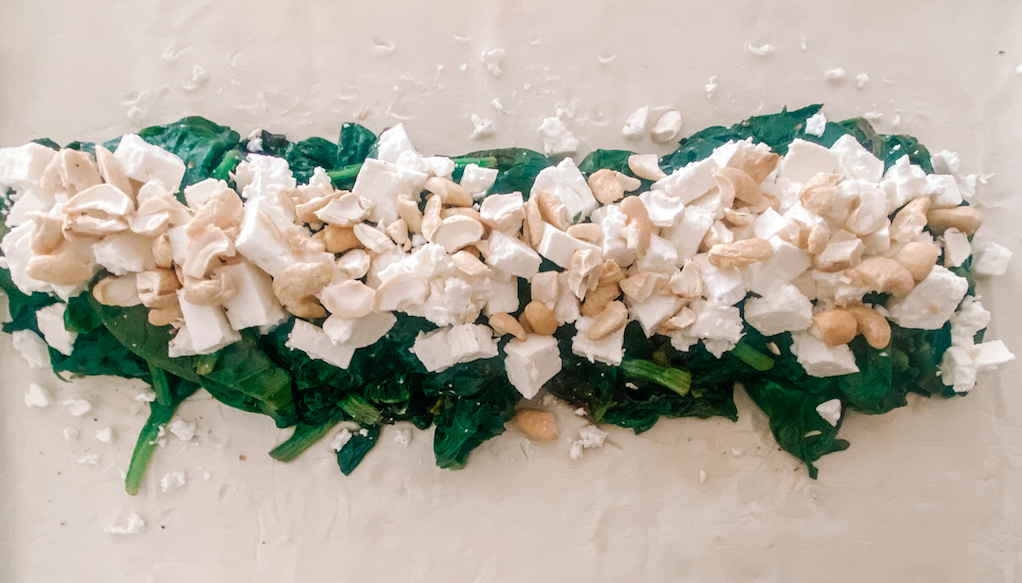Spinach & Wild Garlic Strudel
Springtime is connected to Kapha in Ayurveda.
Kapha dosha has the characteristics of being rather heavy, wet, moist, cold, dense, stable, and sticky.
In order to let go of the heaviness that accumulated during the cold winter months, we put emphasis on leafy greens, lighter and bitter vegetables.
Spinach, kale, dandelion, parsley, fennel, leek, and wild garlic are perfect options during this time of the year.
They balance Kapha dosha with ease, and cleanse your liver and body in a gentle way.
Wild garlic is growing as its name says wildly in Austrian forests these days, it is a natural colon cleanser, boosts our immune system, and is stimulating Kapha. You can incorporate it into the strudel if you want to thrive with the seasons, or leave it out in case you do not like the taste! It’s up to you!
This Austrian spinach strudel is a recipe from my mom, which I have adapted to Ayurvedic standards.
If you are vegan or want an easier-to-digest meal for Kapha, you can simply skip the paneer or feta in this recipe. However, it can be a good addition for Vata dosha.
Cashews are sweet and heavy, calming the nervous system. They help to make this a more dense and grounded meal for all doshas, especially for Vata.
Consumed in high amounts cashews will increase Kapha dosha but the pungent spices and wild garlic will counterbalance this effect.
The spices also help to digest the dough of the strudel.
Fenugreek also called methi is great during this time of year as it is a pungent bitter. It is also a perfect spice to include in a spring cleanse.
Sesame seeds will help you when you feel tired and depleted from the colder months of the year. They are sweet, heating, and astringent and help to contain heat, strengthen your bones, muscles, nerves and lubricate and protect your tissues.
Horseradish in the yogurt dip will help against mucus, a sign of high Kapha. If it is too intense for you, please skip it and simply add chives by itself.
This recipe makes exactly 1 strudel and takes about 40 minutes, longer if you decide to make the dough yourself.
INGREDIENTS
Filling
- 1/8 tsp freshly ground fenugreek (methi)
- 1/4 tsp freshly ground cumin seeds
- 1/4 tsp freshly ground cilantro seeds
- 500 g baby spinach
- 1 cup wild garlic
- pinch black pepper
- 50 g cashews
- paneer, feta or vegan cheese of choice
- 2 tbsp sesame seeds
- 2 tbsp olive oil or ghee
- ready-made strudel dough
Homemade Strudel Dough
- 100 g flour type 700 (flour of your choice)
- pinch rock salt
- 1 tsp vinegar
- 1 tbsp olive oil
Yogurt Dip
- 200 ml (vegan or biodynamic) yogurt
- minced chives
- 1 tbsp grated horseradish
Find out how to make paneer here.
INSTRUCTIONS
Preheat oven to 180 degrees Celsius.
If you want to make the dough yourself:
Put all ingredients for the strudel dough onto a clean surface and knead the dough.
You will need water to make the dough smooth.
Form a ball, brush with oil and let the dough rest at least 30 minutes.
If you are lazy, you can buy an organic one from your local shop.
But the fresher, the more prana it will contain. Self-made is always favored in Ayurveda.
Warm 1 tbsp olive oil in a big pot, add freshly ground fenugreek, cumin, and cilantro. If you do not use wild garlic. Sauté them until their aroma arises.
Now you can put washed baby spinach and wild garlic into the pot and cook for 5 minutes and add freshly ground black pepper.
Then roll out the strudel dough evenly on parchment paper on the baking tray, best into a rectangular form.
Use a kitchen cloth to pat the spinach mix dry.
Place it in the middle of the dough, as seen in the picture below:
Then crumble the cheese of your choice on top, as well as the cashews.
Feta cheese can be quite salty already, so you won’t need more salt. In fact, more salt will not aid Kapha, for it leads to water retention. However, choose rock salt as it does not lead to water retention as much as sea salt does and it contains the highest amount of minerals.
Close the dough now lengthwise and then roll the two ends on the opposite sides towards the strudel, so no liquid will run out.
Brush olive oil onto the strudel and sprinkle with black and white sesame seeds.
Bake it at 180 degrees Celsius for about 15-20 minutes until golden brown.
Meanwhile you can prepare the dip. Mince the chives and add the grated horseradish into your yogurt.
Ayurveda teaches us that salt and cow’s yogurt are incompatible, please avoid adding salt to your dip or chose a plant-based yogurt of your choice.
I hope you enjoy this recipe!
With love,
Lisa




